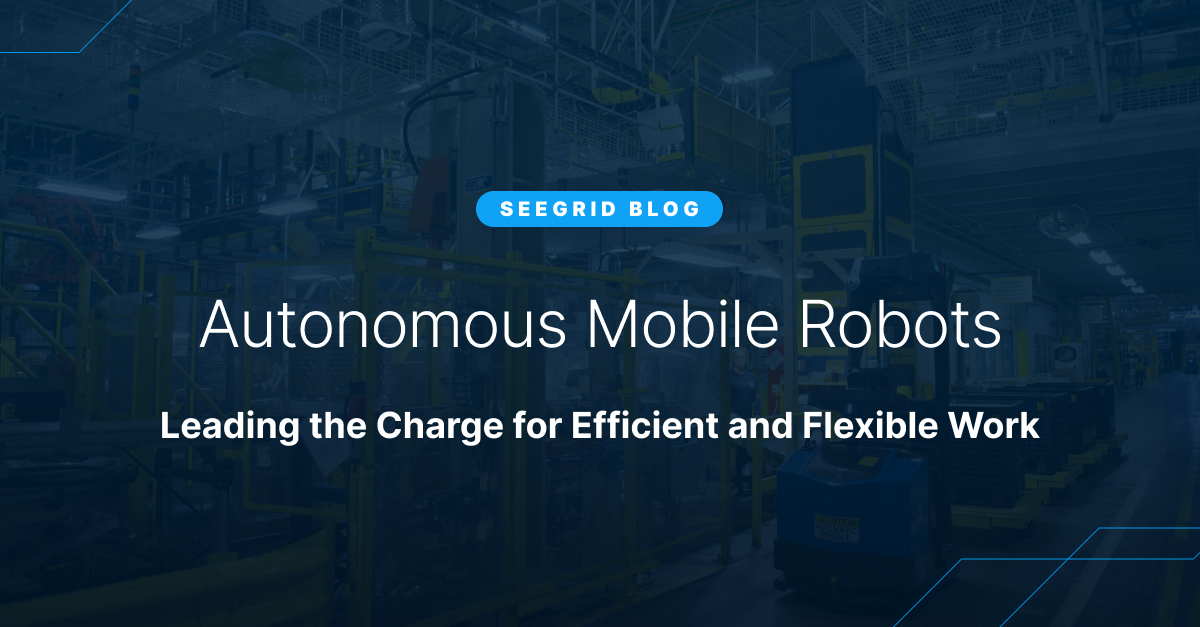Imagine a workforce that never tires, is highly adaptable, and excels at repetitive tasks. That's the power of Autonomous Mobile Robots (AMRs), the cutting-edge technology that is transforming the way we work. From warehouses to distribution centers to manufacturing floors, AMRs are rewriting the rules, providing efficient and flexible solutions. In this blog, we will explore AMR basics, what makes them work, and how they’re poised to change the future of work.
What is an Autonomous Mobile Robot (AMR)?
Autonomous Mobile Robots, commonly referred to as AMRs, are robots designed to perform tasks in dynamic environments. AMRs are powered by complex software platforms and equipped with technologies like sensors and navigation systems. These technologies enable them to perceive their surroundings, make decisions, and move autonomously.
A Brief History of AMRs
AMRs have a history that goes back 75 years. Roboticist Wiliam Grey Walter developed the first AMRs in1948. His robots, Elmer and Elsie, were equipped with light and bump sensors and were capable of successfully navigating obstacles.
The first AMR, created by Roboticist Wiliam Grey Walter
Fast forward 8 decades and AMR technology has made monumental advancements now working alongside humans in warehouses and helping companies achieve double digit improvements for key KPIs. They're part of a $53B market that's expected to grow 18% year over year until 2032. Modern AMRs are capable of performing increasingly complex tasks and can slot into manufacturing, logistics, and warehousing operations.
How do AMRs Work?
AMRs are equipped with a complex network of sensors, including LiDAR (Light Detection and Ranging), cameras, proximity sensors, and encoders. These sensors provide real-time data about the robot's surroundings to the software that controls the robot itself. AMRs then simultaneously use this data to perceive their environment and make safe, intelligent decisions about what to do next.
Sensors and cameras, like the ones that make up Seegrid’s computer vision system, allow AMRs to see the world like we do
Perception
Sensors, such as LiDAR and cameras, enable AMRs to perceive their surroundings in detail. LiDAR sensors function by bouncing lasers off of nearby objects and measuring the time it takes for them to bounce back. LiDAR sensors then leverage that data to create a 3D map of the environment. Cameras provide visual information that help AMRs identify objects, read barcodes, or recognize landmarks.
Learn more about LiDAR and Seegrid's cutting edge perception technology here.
Localization
Localization is the process by which the AMR determines its position within an environment. This is most commonly achieved through Simultaneous Location and Mapping (SLAM) algorithms that combine sensor data with pre-existing maps or by creating maps in real-time. By continuously updating its position, the robot can navigate accurately and efficiently.
Mapping
Mapping refers to the creation and maintenance of an internal map of the environment. As the robot moves, it builds a map that includes obstacles, pathways, and other relevant features. This map serves as a reference for the robot's navigation and ensures it can plan and execute tasks effectively.
What Are the Different Types of AMRs?
AMRs come in different forms, each designed for specific applications. Let's explore some of the common types:
1. Lift Truck AMRs
Lift truck AMRs, like Seegrid's autonomous Lift, are equipped with lifting mechanisms to handle heavy loads, such as pallets or large containers. They can lift and transport various load types to their designated locations with precision and efficiency, contributing to more streamlined warehouse operations.
2. Tow Tractor AMRs
Tow tractor AMRs are specifically designed to pull or tow carts or trailers. Tuggers are used in warehouse settings for material handling tasks, like moving goods and materials between different workstations or assembly lines.
They can navigate through complex environments, avoiding obstacles, and optimizing transport routes. Tugger AMRs are particularly useful in industries like manufacturing, where they facilitate just-in-time material delivery.
Two tow tractor AMRs in action
3. Pallet Truck AMRs
Pallet truck AMRs are specialized robots capable of handling palletized loads. They can autonomously pick up and transport pallets, ensuring efficient movement and organization of goods within a warehouse or distribution center.
4. Unit Load AMRs
Unit Load AMRs are specialized in handling large, pre-defined loads, often in the form of pallets or containers. These robots are most commonly used in manufacturing facilities, warehouses, and distribution centers. Unit Load AMRs are often used to transport product to put away and for long-haul transport of loads from receiving to staging or staging to shipping.
5. Sorting AMRs
Sorting AMRs automate the process of sorting items based on predefined criteria. They can scan, identify, and divert items into specific bins or conveyors, improving the efficiency of order processing and distribution.
6. Picking AMRs
These robots are specialized in autonomously picking up objects or products from one location and placing them in another. Picking AMRs play a crucial role in order fulfillment processes. These robots are most commonly found in e-commerce warehouses, where they perform a wide variety of tasks.
Why Use AMRs?
The adoption of AMRs offers several benefits for businesses seeking automation solutions:
Safety
One of the key advantages of AMRs is enhanced safety in the workplace. By automating tasks that are physically demanding or involve exposure to hazardous conditions, AMRs reduce the risk of accidents and injuries. This not only protects human workers but also minimizes the potential for damage to goods or equipment.
Learn more about how AMRs are improving safety.
Productivity
AMRs play a crucial role in boosting productivity. By automating manual processes and reducing reliance on human labor, businesses can increase throughput, reduce errors, and optimize resource utilization. AMRs work around the clock, ensuring consistent performance and faster order fulfillment.
The skills gap and labor shortage have hindered productivity, AMRs help address both of these problems. By automating non-value added tasks, AMRs give workers the opportunity to perform more engaging, value-added work. Ensuring workers are engaged not only improves productivity, but it reduces turnover and increases morale.
A tow tractor AMR pulling 4 carts
Efficiency
AMRs improve efficiency by streamlining processes and saving time. AMRs can optimize travel routes, minimize idle time, and perform tasks with consistent speed and precision. AMRs are particularly good at long-haul travel, a task that can occupy hours of work every day. With anability to work 24/7 and handle repetitive tasks, AMRs help businesses achieve higher productivity levels.
Flexibility
Above all else, AMRs are flexible. AMRs can adapt to different environments and support various tasks across manufacturing, logistics, and distribution processes. Whether it's navigating complex warehouse layouts or moving through crowded manufacturing floors, AMRs can adapt to changing conditions safely and efficiently.
What Industries Are Getting the Most Benefit From AMRs?
AMRs are versatile and support applications in various industries. Some of the sectors that benefit from the use of AMRs include manufacturing, warehousing, logistics, and healthcare.
AMRs for Manufacturing
In the manufacturing industry, AMRs are employed for material handling, assembly line support, and quality control. These robots can transport raw materials, deliver components to workstations, or assist in repetitive assembly tasks. By automating these processes, AMRs contribute to improved efficiency and product quality.
Learn more about how AMRs help Whirlpool increase safety and simplify their parts delivery processes.
AMRs in action at a Whirlpool manufacturing facility
AMRs for Warehouse Automation
AMRs are revolutionizing warehouse operations by automating tasks such as inventory management, order picking, and goods transportation. They can navigate through dynamic warehouse environments, pick items from shelves, and transport them to the pick area or packing station. AMRs optimize order fulfillment processes, reduce errors, and ensure timely delivery of goods.
Learn more about how AMRs reduce wasted travel time for powered industrial truck operators at Giant Eagle.
AMRs for Logistics
In the logistics sector, AMRs streamline the movement of goods within distribution centers, ports, and transportation hubs. They can autonomously load and unload trucks, transport goods between different storage areas, and assist in the sorting and distribution of packages. AMRs enhance logistics efficiency by minimizing delays, optimizing space utilization, and improving overall supply chain performance.
Learn more about how DHL leverages AMRs to increase safety and productivity.
AMRs Are Shaping the Future
Autonomous Mobile Robots (AMRs) are revolutionizing industries by providing flexible, efficient, and safe automation solutions. These versatile robots are transforming manufacturing, warehousing, logistics, and other sectors by optimizing operational processes and enhancing productivity. As technology continues to advance, the potential for AMRs to revolutionize the way we work and automate tasks is only growing.
Frequently Asked Questions About AMRs
AMRs and Automated Guided Vehicles (AGVs) are two types of mobile robots used for automation. The biggest difference between the two is that AMRs are autonomous and do not require fixed infrastructure. AMRs navigate using maps either created by its software or by pre-loaded maps of the facility. By contrast, AGVs often rely on magnetic tapes and wire to navigate. AMRs are more flexible and adaptable to dynamic environments, while AGVs are better suited for repetitive tasks.
AMRs are equipped with obstacle detection and avoidance systems. When an obstacle is detected, the robot's algorithms analyze the situation and determine the best course of action. This may involve re-routing, slowing down, or stopping to avoid a collision. The advanced sensors and algorithms ensure that AMRs can navigate safely in complex environments.
The adoption of AMRs does not necessarily mean job loss. Instead, AMRs can augment human workers by automating repetitive or physically demanding tasks, allowing employees to focus on more value-added activities. Interested in learning more? Check out our blog on the subject here.
In order to get the most value from your AMRs, you need to work with a vendor that can help you carefully plan, effectively implement, and continuously iterate and improve. Like any technology, it’s not as simple as flipping a switch. Maximizing the value you get from your AMRs and achieving ROI depends heavily on choosing the right workflows to automate, implementing the right AMR solution, and seeing it through. Check out our blog on how to effectively plan and budget for automation to increase your ROI here.






